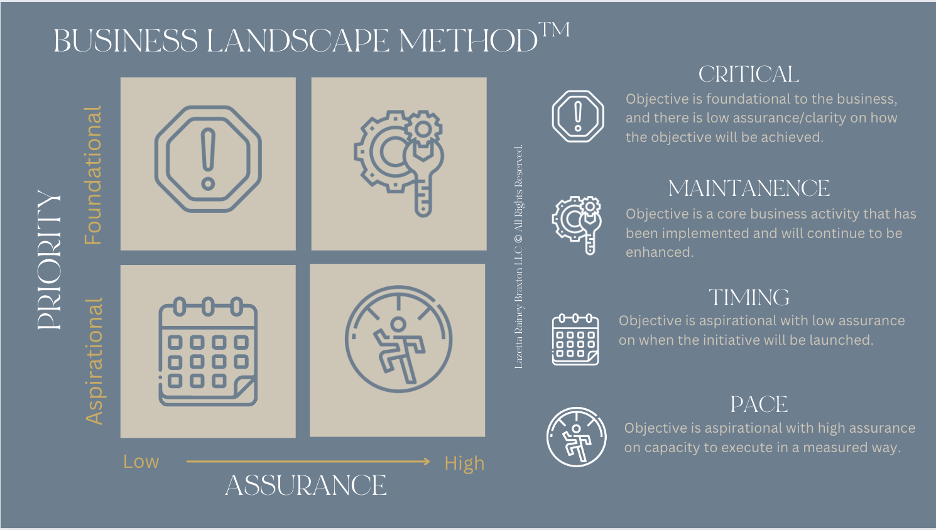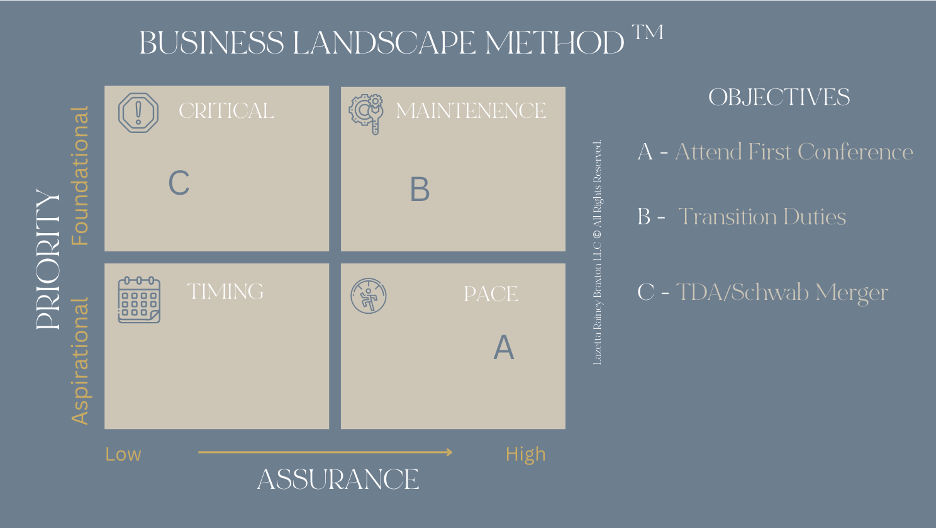[ad_1]
Business owners often carry the responsibility for managing all aspects of their RIA firms— strategy, services, positioning, business development and the list goes on. This approach leaves leaders burned out and team members buried in tactical execution with their heads down and hearts despondent.
Savvy leaders recognize the value of including team members in achieving the firm’s growth objectives. We inherently trust their capability in advancing the firm’s success. After all, our employees are our biggest assets.
The Business Landscape Method invites all firm members to co-create the firm’s business landscape. This method honors the experiences, voices and perspectives of each team member as a valued contributor. Together, everyone owns the strategic direction of the firm. Teamwork makes the dream work!
Let’s examine the Business Landscape Method together.
Identify the Framework and Themes for the Strategic Planning Process
Frameworks and themes set the purpose and tone for any engagement, including the strategic planning process. These guideposts enhance the execution of the firm’s growth strategy. They encapsulate the firm’s culture as influenced by the firm’s vision, mission and values statements.
As an example, our anchoring framework and themes for our 2023 objectives at 2050 Wealth Partners are care, capacity, communication and craft. Care signals goodwill and good faith when interacting with team members. Communication is essential in maximizing efficiencies and minimizing misunderstandings. Capacity involves the sharing and negotiating of work priorities among team members. Honing our craft as financial planners ensures that we bring consistent value to our clients.
Highlight Potential Obstacles in Meeting Objectives
My dad would always encourage me to enter a situation with my “eyes wide open.” His point: know yourself well enough to navigate what may be ahead of you. This wisdom applies well to RIAs in embracing their current cultural temperament.
For the 2050 WPs team, we identified these key considerations to be mindful of: energy levels, undercurrents, assumptions, unexpected situations and intentional space. Our energy levels vary based on circumstances at home and at work. When we gather in our huddles, we start the meeting with an “Energy Check,” inviting each person to share their energy levels. Responses offer clear guidance on the capacity of each person and the collective team. We also instituted the “Stretched Situation or Season” concept, which empowers team members to share if their energy levels are impacted by a stretch situation or stretched season in their lives. We all have them! When we feel empowered to express how we feel and what we are experiencing, we minimize “undercurrents,” or suppressed emotions, that impede our productivity and induce F.O.G.S.—fear, obligation, guilt and shame.
Assumptions often surface when miscommunication arises. We all have scripts, good or bad, about duties and responsibilities and tend to project these scripts based on our experiences. A culture of care invites these assumptions to be examined through the lens of psychological safety.
Even for the most well-oiled RIA, unexpected situations catch many firms off guard. We orchestrate our businesses with our best efforts rooted in a value-based culture with well-crafted policies, processes and procedures. We affirm that business and life surprises give us the opportunity to test our systems and provide instruction on enhancements.
Having intentional space in the workplace to absorb business and life shocks requires both structure and flexibility. Energy needs a place to travel; stretch seasons, undercurrents, assumptions and surprises require time to navigate. It takes courage and trust to believe that the work will get done in a way that moves everyone forward.
Brainshare on the Strategic Objectives and Map the Business Landscape
Once the framework, themes and considerations have been outlined, the team is ready to brainshare on the firm’s strategic objectives. It is important to define the time frame to guide the feasibility of the goals. A one-year horizon is a great starting point.
Here are two approaches for identifying the firm’s annual strategic objectives:
- Top-of-Mind Approach
- Ask team members their top-of-mind objectives for individual and collective success
- Categorical Approach
- Provide categories and ask for insights. Category examples include career development, team capacity, core business functions, operational enhancement and tech implementation, to name a few.
Invite members to consider one or two specific objectives in each category. For example, in career development, a team member’s objective may be “Attend my first financial professional conference.” For team capacity, the objective could be “Transition Duties for [Team Member]” for a team member going on leave. Another objective may be related to a business-related timeline such as the implementing the TD Ameritrade/Schwab merger firmwide. After curating the firm’s objectives together, determine how they will be mapped to the Business Landscape.
The Business Landscape is a quadrant chart mapping team objectives from foundational to aspirational as firm priorities, ranging from low to high assurance of implementation in the year. The CRITICAL quadrant identifies objectives that are foundational to the business with low assurance on their achievability. The MAINTENANCE quadrant represents implemented core business activities that require ongoing attention. The TIMING quadrant details aspirational objectives with low assurance on the capacity necessary to explore the objective. The PACE quadrant captures aspirational objectives with high assurance of achievement based on measured efforts.

Using a previous example, the team member leads the discussion on the “Attend my first financial professional conference,” objective with the team. The considerations for its placement on the Business Landscape may include capacity (time away from the office), craft (training/education), community (professional engagement) and currency (firm budget and available scholarships). With guidance from the RIA leaders, the team member will place the objective in one of the quadrants on the firm’s Business Landscape working document. This process of discussion and mapping continues until all objectives are addressed.

Next, the team decides who will create the project plan for addressing the objective’s “who, what, where, when and how” details. Project management software such as Notion and Click Up are recommended to track objectives, ownership and progress.
The investment of time and effort in the Business Landscape Method yields great dividends firmwide. As advisors, it gives us the opportunity to practice what we preach with designing, implementing and monitoring a plan anchored in our values and goals. In the spirit of Hannibal on the infamous show, The A-Team, we “love it when a plan comes together!”
Lazetta Rainey Braxton the founder/CEO of Lazetta & Associates and co-CEO at 2050 Wealth Partners.
[ad_2]
Source link

